
Бази даних
Наукова періодика України - результати пошуку
 |
Для швидкої роботи та реалізації всіх функціональних можливостей пошукової системи використовуйте браузер "Mozilla Firefox" |
|
|
Повнотекстовий пошук
| Знайдено в інших БД: | Реферативна база даних (16) |
Список видань за алфавітом назв: Авторський покажчик Покажчик назв публікацій  |
Пошуковий запит: (<.>A=Chegel V$<.>) | |||
|
Загальна кількість знайдених документів : 9 Представлено документи з 1 до 9 |
|||
| 1. | 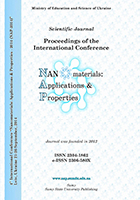
Chegel V. Preparation of Au Nanostructure Arrays for Fluorometry and Biosensors Applications [Електронний ресурс] / V. Chegel, A. Lopatynskyi, V. Lytvyn, V. Nazarenko, J. Guo, B. Lucas // Proceedings of the International Conference Nanomaterials: Applications and Properties. - 2012. - Vol. 1, no. 2. - С. 02NNBM27-02NNBM27. - Режим доступу: http://nbuv.gov.ua/UJRN/princon_2012_1_2_63 | ||
| 2. | 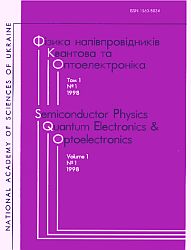
Lopatynskyi A. Comparative analysis of response modes for gold nanoparticle biosensor based on localized surface plasmon resonance [Електронний ресурс] / A. Lopatynskyi, O. Lopatynska, V. Chegel // Semiconductor physics, quantum electronics & optoelectronics. - 2011. - Vol. 14, № 1. - С. 114-121. - Режим доступу: http://nbuv.gov.ua/UJRN/MSMW_2011_14_1_21 The theoretical comparison of possible response measurement techniques for a biosensor based on localized surface plasmon resonance (LSPR) in spherical Au nanoparticle was made. The methods for measuring LSPR response considered differed in the treatment of the change of light extinction spectrum along the wavelength and extinction coordinate axes upon the formation of dense biomolecular monolayer on the surface of the sensitive element. In addition, the transformation of the extinction LSPR band with increase of the nanoparticle radius from 5 to 125 nm was investigated towards the optimization of LSPR response for dipolar and quadrupolar LSPR extinction peaks. A novel method for the measurement of wavelength shift <$E H sub top sup +> was introduced and demonstrated to be more effective for estimation of the LSPR biosensor response as compared to commonly measured extinction peak shift <$E DELTA lambda sub max>. These techniques were proved to produce maximal LSPR response when large-size Au nanoparticle (with a radius of 125 nm) was used as a sensitive element of biosensor. The preferable mode of extinction difference measurement turned out to be <$E V sub right>, which is carried out at a wavelength of the extreme extinction spectrum derivative on a right slope of the LSPR peak. For this method, optimal nanoparticle radii were found to be about 40 nm for the dipolar LSPR peak and near 100 - 105 nm for the quadrupolar one. | ||
| 3. | 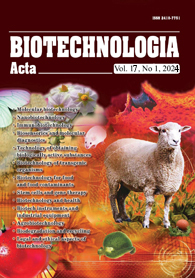
Chegel V. I. High-conductive nanostructures in biochemical studies: fluorescence enhancing [Електронний ресурс] / V. I. Chegel, A. M. Lopatynskyi, V. К. Lytvyn, O. M. Naum, V. I. Nazarenko, А. P. Demchenkо // Biotechnologia Acta. - 2015. - Vol. 8, № 5. - С. 9-18. - Режим доступу: http://nbuv.gov.ua/UJRN/biot_2015_8_5_3 Описаны экспериментальные и теоретические исследования затухания и усиления флуоресценции высокопроводимыми наночастицами и массивами наноструктур на твердотельных носителях (наночипах). Приведены данные литературы и собственных исследований авторов относительно возможности изменения сигнала флуоресценции красителя наноструктурами золота и серебра. Осуществлено моделирование и сравнительное исследование образцов с наноструктурами высокопроводящих металлов как активных элементов для регулирования сигнала флуоресценции. Методом термического отжига высокопроводящих островковых пленок золота и серебра изготовлены экспериментальные образцы наночипов. С использованием разработанного авторами лазерного флуориметра FluorotestNano показано, что интенсивность флуоресценции красителя Р6Ж может быть усилена не менее чем в 20 - 25 раз вблизи наноструктур золота путем удаления красителя на расстояние 20 нм с помощью диэлектрического покрытия SiO2. Применение наноструктур высокопроводящих металлов для регулирования сигнала флуоресценции открывает перспективные направления исследований, в частности увеличение чувствительности флуоресцентных методов, флуоресцентной микроскопии и медицинской диагностики, а также разработка новых биосенсоров. | ||
| 4. | 
Chegel V. I. Plasmon-enhanced fluorometry based on gold nanostructure arrays. Method and device [Електронний ресурс] / V. I. Chegel, V. K. Lytvyn, A. M. Lopatynskyi, P. E. Shepeliavyi, O. S. Lytvyn, Yu. V. Goltvyanskyi // Semiconductor physics quantum electronics & optoelectronics. - 2015. - Vol. 18, № 3. - С. 272-278. - Режим доступу: http://nbuv.gov.ua/UJRN/MSMW_2015_18_3_8 In this work, we describe a method of surface-enhanced fluorometry, based on the phenomenon of localized surface plasmon resonance in unordered gold nanostructure arrays. The theoretical approach for the model system "gold nanoparticle-dielectric spacer" in the electrostatic approximation by solution of Laplace's equation is considered. The developed technology for manufacturing the plasmonic substrates as well as design of the novel laser-based compact fluorometer are presented. The arrays of gold nanostructures on solid substrates (nanochips) coated with different thicknesses of SiO | ||
| 5. | 
Lopatynska O. G. Localized surface plasmon resonance in Au nanoprisms on glass substrates [Електронний ресурс] / O. G. Lopatynska, A. M. Lopatynskyi, T. I. Borodinova, V. I. Chegel, L. V. Poperenko // Semiconductor physics, quantum electronics & optoelectronics. - 2015. - Vol. 18, № 4. - С. 410-415. - Режим доступу: http://nbuv.gov.ua/UJRN/MSMW_2015_18_4_8 Metal nanocrystals are actual objects for the modem biophysics mainly because of their usage in sensors based on localized surface plasmon resonance (LSPR) and as active substrates for surface-enhanced spectroscopies. This work deals with the experimental and theoretical investigation of optical properties of trigonal and hexagonal Au nanoprisms deposited on the glass substrates. It was confirmed for the studied structures that the LSPR spectra depend on the crystals shape and size. Theoretical modeling the optical properties of plasmon-supporting nanoprisms was performed using the fmite-difference time-domain method. The experimentally obtained and theoretically modeled LSPR spectral positions were found to be different, which can be attributed to a high spread of nanoprism shapes and sizes in the same sample and to nanocrystals aggregation effect confirmed by microscopy data. Additionally, the distributions of the electric field in the vicinity of nanoprisms under the LSPR conditions were simulated, and a strong field intensity enhancement at the comers of the prisms was demonstrated, which implies the promising application of such plasmonic nanostructures for surface-enhanced spectroscopy. | ||
| 6. | 
Lopatynskyi A. M. Smart nanocarriers for drug delivery: controllable LSPR tuning [Електронний ресурс] / A. M. Lopatynskyi, V. K. Lytvyn, I. V. Mogylnyi, O. E. Rachkov, O. P. Soldatkin, V. I. Chegel // Semiconductor physics, quantum electronics & optoelectronics. - 2016. - Vol. 19, № 4. - С. 358-365. - Режим доступу: http://nbuv.gov.ua/UJRN/MSMW_2016_19_4_8 Gold nanostructures are considered as a potential platform for building smart nanocarriers that will form the basis of novel methods of targeted delivery and controlled release of drugs. However, to ensure maximum efficiency of gold nanoparticles upon the drug release via the plasmon-enhanced photothermal effect, it is necessary to optimize their spectral parameters for operation in the human body that requires both theoretical research and development of appropriate methods for nanostructures fabrication. In this work, mathematical modeling of light extinction spectral dependences for gold nanostructures of different morphology was performed to determine their geometric parameters that provide the occurrence of localized surface plasmon resonance (LSPR) in the red and near infrared regions of the spectrum, where the transparency window of biological tissues exists. Based on the results of previous studies and computer modeling, using hollow gold nanoshells to construct smart nanocarriers was found to be most reasonable. A protocol for production of these nanoparticles based on "silver-gold" galvanic replacement reaction, which is accompanied by a controlled shift of the LSPR wavelength position, was proposed and described in detail. It is shown that the loading of model biomolecules in hollow gold nanoshells significantly changes the output optical parameters of the system under investigation, which should be taken into account for matching with the laser excitation wavelength during the development of smart nanocarriers. | ||
| 7. | 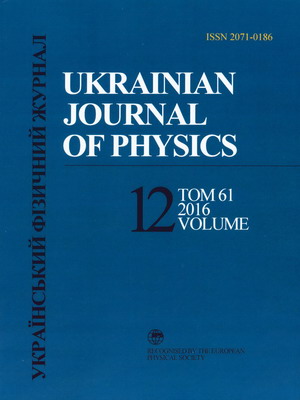
Goncharenko N. A. Complexation peculiarities in "Doxorubicin–Bovine Serum Albumin–Gold Nanoparticles” heterosystem. The fluorescence study [Електронний ресурс] / N. A. Goncharenko, O. P. Dmytrenko, О. L. Pavlenko, M. P. Kulish, I. P. Pundyk, А. I. Lesyuk, T. O. Busko, А. М. Lopatynskyy, V. І. Chegel, V. K. Lytvyn, M. I. Kaniuk // Ukrainian journal of physics. - 2020. - Vol. 65, № 6. - С. 468-475. - Режим доступу: http://nbuv.gov.ua/UJRN/Ukjourph_2020_65_6_4 | ||
| 8. | 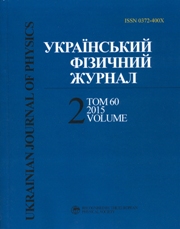
Goncharenko N. A. Complexation peculiarities in "Doxorubicin–Bovine Serum Albumin–Gold Nanoparticles” heterosystem. The fluorescence study [Електронний ресурс] / N. A. Goncharenko, O. P. Dmytrenko, О. L. Pavlenko, M. P. Kulish, I. P. Pundyk, А. I. Lesyuk, T. O. Busko, А. М. Lopatynskyy, V. І. Chegel, V. K. Lytvyn // Український фізичний журнал. - 2020. - Т. 65, № 6. - С. 464-471. - Режим доступу: http://nbuv.gov.ua/UJRN/UPhJ_2020_65_6_4 | ||
| 9. | 
Neimash V. B. The role of tin in the formation of micro- and nano-structured surfaces of layered Si–Sn–Si films [Електронний ресурс] / V. B. Neimash, P. E. Shepelyavyi, A. S. Nikolenko, V. V. Strelchuk, V. I. Chegel, I. V. Olkhovyk, S. O. Voronov // Ukrainian journal of physics. - 2023. - Vol. 68, № 4. - С. 284-291. - Режим доступу: http://nbuv.gov.ua/UJRN/Ukjourph_2023_68_4_9 | ||
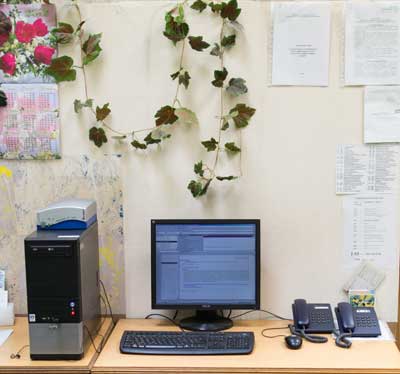 |
| Відділ наукової організації електронних інформаційних ресурсів |
 Пам`ятка користувача Пам`ятка користувача |